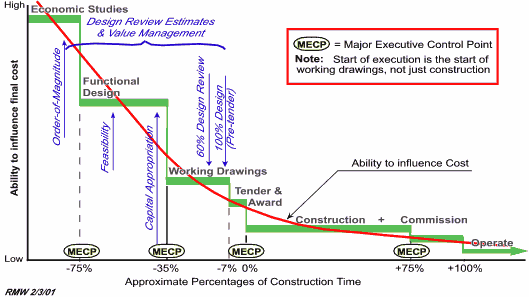The Significance of Project Management during the Design Stages
For the reasons just noted, significant management effort must be applied to,
and accepted by, the design team during the planning phases of the project, if
satisfactory control is to be maintained. Similarly, undue re-examination or shifts
in original scope must be avoided by the owner/sponsor if design development is
to proceed efficiently and on schedule. Conversely, if this work does come in
for significant revision it is clear that the project is not in fact ready to
move forward into more detailed work. In this case, the project should be paused
until the issues are properly sorted out.

Figure 6: Ability to Influence Final Cost [3]
It cannot be over emphasized how important it is to have a high caliber presentation
of drawing, rendering and schematics for approval at the end of the Development
phase. It is on this basis that the major investment decision will be made. If
there are any doubts here, these will be greatly magnified during execution.
Far better to stop work and reconsider. It is not generally understood that
it is far more difficult, and costly in design time, to make major changes to
an existing design than it is to start from scratch. This is because of the added
careful coordination required and the higher probability and danger of overlooking
the impact on a related system.
During execution the contractor is certainly able to influence cost toward
a favorable variance, but only to a much lesser extent. It is also common experience
that cost saving or cost cutting efforts at this stage rarely return one hundred
cents on the dollar. Aside from giving the contractor opportunities to improve
profit margins, disruption, delay and possibly wasted effort and materials are
genuine and legitimate offsets.
3. Wideman, R. M., Cost Control of
Capital Projects, BiTech Publishers, Vancouver, BC, Canada, Second Edition, 1995.
|



